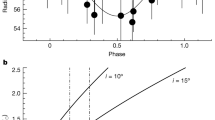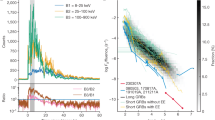Abstract
Ultra-high-energy (UHE) γ-ray emission from Cygnus X-3 (refs 1,2) and the several other binary X-ray sources has been observed at γ-ray energies ≥1015 eV (refs 3–5). Also, collisionless shocks are expected to form in accretion flows onto neutron stars or black holes6. Here, therefore, we consider the diffusive shock acceleration of ions as the mechanism responsible for the γ-ray emission observed. The shock acceleration time can under reasonable assumptions be sufficiently short to allow acceleration of ions to energies near 1016 eV. We propose that the subsequent proton–proton (p–p) collisions and photodissociation of 4He can produce a flux of neutrons that escapes from the acceleration site despite the high magnetic fields (∼108 G). These neutrons, by interacting with the binary companion7,8, produce the observed UHE radiation. Radiation at such energies might be a common property of accreting binaries.
This is a preview of subscription content, access via your institution
Access options
Subscribe to this journal
Receive 51 print issues and online access
$199.00 per year
only $3.90 per issue
Buy this article
- Purchase on Springer Link
- Instant access to full article PDF
Prices may be subject to local taxes which are calculated during checkout
Similar content being viewed by others
References
Samorski, M. & Stamm, W. Astrophys. J. Lett. 268, L17–L21 (1983).
Lloyd-Evans, J. et al. Nature 305, 784–787 (1983).
Baltrusaitis, R. M. et al. Astrophys. J. Lett. 293, L69–L72 (1985).
Protheroe, R. J., Clay, R. W. & Gerhardy, P. R. Astrophys. J. Lett. 280, L47–L50 (1984).
Protheroe, R. J. & Clay, R. W. Nature 315, 205–207 (1985).
Hawley, J. F., Smarr, L. L. & Wilson, J. R. Astrophys. J. Suppl. 55, 211–246 (1984).
Vestrand, W. T. & Eichler, D. Astrophys. J. 261, 251–258 (1982).
Hillas, A. M. Nature 312, 50–51 (1984).
Eichler, D. & Vestrand, W. T. Nature 307, 613–614 (1984).
Chanmugam, G. & Brecher, K. Nature 313, 767–768 (1985).
Krymsky, G. F. Dokl. Akad. Nauk SSSR 234, 1306–1308 [Soviet Phys. Dokl. Engl. transl. 22, 327–328 (1977)].
Axford, W. I., Leer, E. & Skadron, G. Proc. 15th int. Cosmic Ray Conf., Plovdiv 11, 132–137 (1977).
Bell, A. R. Mon. Not. R. astr. Soc. 182, 147–156 (1978).
Blandford, R. D. & Ostriker, J. P. Astrophys. J. Lett. 221, L29–L32 (1978).
Lee, M. A. Rev. Geophys. Space Phys. 21, 324–338 (1983).
Ellison, D. C. J. geophys. Res. 90, 29–38 (1985).
Ellison, D. C. & Ramaty, R. Astrophys. J. 298, 400–408 (1985).
Axford, W. I. Proc. 17th int. Cosmic Ray Conf., Paris 12, 155–203 (1981).
Ellison, D. C. & Eichler, D. Phys. Rev. Lett. 55, 2735–2738 (1985).
Eichler, D. & Wiita, P. J. Nature 274, 38–39 (1978).
Stephens, S. A. & Verma, R. P. Nature 308, 828–830 (1984).
Hillas, A. M. A. Rev. Astr. Astrophys. 22, 425–444 (1984).
Eichler, D. & Vestrand, W. T. Proc. 19th int. Cosmic Ray Conf., La Jolla 1, 115–118 (1985).
Stecker, F. W., Harding, A. K. & Barnard, J. J. Nature 316, 418–420 (1985).
White, N. E. & Holt, S. S. Astrophys. J. 257, 318–337 (1982).
Stecker, F. W. Phys. Rev. Lett. 21, 1016–1018 (1968).
Protheroe, R. J. Nature 310, 296–298 (1984).
Kinsey, J. H. Astrophys. J. 158, 295–302 (1969).
Ellison, D. C. & Eichler, D. Astrophys. J. 286, 691–701 (1984).
Gaisser, T. K. & Yodh, G. B. A. Rev. nucl. part. Sci. 30, 475–542 (1980).
Marshak, M. L. et al. Phys. Rev. Lett. 54, 2079–2082 (1985).
Battistoni, G. et al. Phys. Lett. 155B, 465–468 (1985).
Author information
Authors and Affiliations
Rights and permissions
About this article
Cite this article
Kazanas, D., Ellison, D. Origin of ultra-high-energy γ-rays from Cygnus X-3 and related sources. Nature 319, 380–382 (1986). https://doi.org/10.1038/319380a0
Received:
Accepted:
Published:
Issue Date:
DOI: https://doi.org/10.1038/319380a0
This article is cited by
-
TeV emission from close binaries
Space Science Reviews (1995)
-
Absorption of gamma-rays by X-ray photons around an accretion binary source
Astrophysics and Space Science (1993)
-
Putting a project on ice
Nature (1991)
-
The plasma physics of shock acceleration
Space Science Reviews (1991)
Comments
By submitting a comment you agree to abide by our Terms and Community Guidelines. If you find something abusive or that does not comply with our terms or guidelines please flag it as inappropriate.



